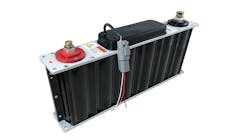Eaton develops suite of 48V technologies
Power management company Eaton announced its Vehicle Group has developed a series of 48V technologies to assist its global on- and off-highway commercial vehicle customers transitioning from traditional 12V and 24V vehicle systems to systems that include 48V architecture. These 48V systems can power new, advanced energy-consuming components and can help reduce emissions and improve fuel economy and performance.
“This development comes as global vehicle manufacturers are making decisions to adopt new technologies to meet emissions regulations,” said Ben Karrer, manager, technology development, Eaton’s Vehicle Group. “Of the options available, 48-volt architectures are becoming more popular because they can decrease both CO2 and NOx simultaneously, which helps both our customers and the environment.”
Most vehicles have traditionally operated with a 12V system, but with tightening fuel economy regulations and new, advanced power-consuming components being added, increasing power needs are driving the move toward 48V systems.
Many vehicle systems today are powered directly from mechanical power generated by the engine, which runs 12V systems such as air conditioning and pumps. Eaton is developing 48VV systems that include motor generators and inverters that generate 48V DC power for the vehicle. Eaton also produces 48V DC/DC converters that step power down from 48V vehicle architectures to power 12V and 24V systems.
Collectively, new emissions regulations will reduce tailpipe NOx limits by up to 90%, accelerating the need for global engine manufacturers to employ additional emissions reduction strategies.
Eaton’s Vehicle Group is also developing power electronics for 48VV electric catalyst heating, which provides heat directly to the vehicle’s aftertreatment system. This active heating helps catalyst components reach efficient operating temperatures faster upon engine start and maintain those temperatures during low load operation. This will be an essential strategy for reducing emissions to the levels required by future regulations.
“Forty-eight-volt power will also be used to power systems such as HVAC and the engine cooling fan, which are traditionally run by the engine,” said Karrer. “Today’s systems are not intelligent—you can’t control when they’re on or off or adjust the levels. Converting those components to electric alternatives allows you to intelligently control them and eliminate mechanical loads.”
An electrical engine cooling fan and electric air conditioning compressor are also under development. Electrifying the cooling fan provides additional benefits, as it could be reduced in size and strategically placed within the engine bay, allowing for aerodynamic design flexibility to increase fuel economy and reduce emissions.
Eaton’s Vehicle Group is developing a wide range of 48V energy storage solutions, including lead-acid batteries and supercapacitors.
“We’re integrating various energy storage technologies into a larger storage pack including controls, fusing, and contactors,” said Karrer. “Eaton’s Electrical Components Group is our partner for supercapacitors, and we will be working with most commercial vehicle battery manufacturers for lead-acid batteries.”
Lead-acid batteries are inexpensive compared to lithium-ion packs and offer a safe and more efficient solution, with a longer lifespan when compared to existing lead-acid battery applications.
Supercapacitors are able to quickly charge and discharge at higher rates than lithium-ion batteries. While the size and weight are comparable to lithium-ion packs, supercapacitors don’t retain high levels of energy in comparison or require a liquid cooling system, and they have a longer cycle life.
This suite of technologies is an example of how Eaton is working to achieve its 2030 Sustainability Targets, which include reducing the carbon emissions from our operations by half and lowering product and supply chain emissions.
